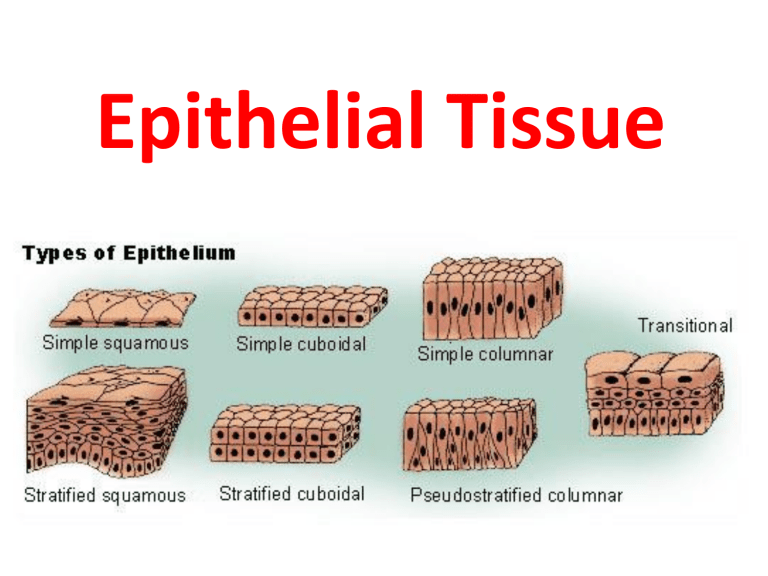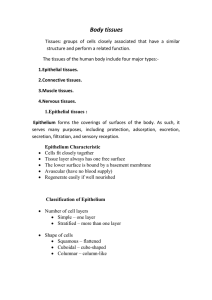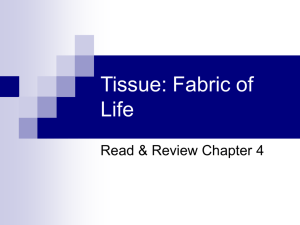
Epithelial Tissue Cells and Tissues Cells are the building blocks of all living things Tissues are groups of cells that are similar in structure and function – protection, absorption, secretion, movement, electrical impulses, etc. Tissues • Four types of tissue – Epithelial = covering – Connective = support – Muscle = movement – Nervous = control • Most organs contain all 4 types • Connective tissue has non-living extra-cellular material (matrix) between its cells • Epithelial – Covers body surfaces – Lines body cavities – Lines hollow organs – Ducts – Forms glands Tissues Tissues • Connective – Protection and support – Binds organs together – Stores energy – bone marrow – Immunity Tissues • Muscle – Movement Tissues • Nerve – Detects change – Nerve impulses – Homeostasis Epithelial Tissue • Tightly packed cells • Cell Junctions – form continuous sheets held together by cell junctions. – Tight junctions – Nothing passes through • Surfaces – apical, lateral and basal Apical surface Basal surface 40 m Basal lamina Polarity of epithelia Epithelial Tissues Found in different areas Body coverings Body linings Glandular tissue Functions Protection – Skin, lining of internal organs Absorption – intestines Filtration – Kidney Secretion – Hormones, mucus, sweat, etc. 1. Epithelial Tissue Stratified squamous epithelium Cuboidal epithelium Simple columnar epithelium Simple squamous epithelium Pseudostratified columnar epithelium Epithelial Tissues Two types: 1. Covering and lining epithelium • • • • • Outer covering of skin, and internal organs Body cavities Blood vessels and ducts Interior of respiratory, digestive, urinary and reproductive organs Parts of sense organs 2. Glandular epithelium • Secreting portion of glands Epithelium Characteristics Cells fit closely together Tissue layer always has one exposed surface (Apical surface) The lower surface (basal surface) is bound by a basement membrane – Fibers The side surface (lateral surface) is bound to other epithelial cells. Avascular (have no blood supply) Nerve supply Regenerate easily if well nourished Classification of Epithelium Number of cell layers Simple – one layer: diffusion (lungs), osmosis, filtration (kidneys), secretion (glands), absorption (intestines) Stratified – more than one layer: protection, secretion Figure 3.16a Classification of Epithelium Shape of cells Squamous – flattened Cuboidal – cube-shaped Columnar – column-like Cilia 1. Nonciliated – absorptive cells (microvilli) and goblet cells (secrete mucus) 2. Ciliated – to move substances (Ex. Ovaries) Figure 3.16b Simple Epithelia Type Cell shape Example Squamous Squashed Cuboid al Cubed Endotheliu m (lin es blood vessels), mesothelium (serous lining of celom) Walls of glands Columnar Columns Pseudo-stratified Flat cells give rise to columns Human Anatomy, Larry M. Frolich, Ph.D. Linin g of gut tube; sometimes with cilia lik e lining of uterine tube With cilia in respiratory tubes to move mucous/particles out of lungs Simple Epithelium Simple squamous Single layer of flat cells Usually forms membranes Lines body cavities Lines lungs and capillaries Figure 3.17a Simple Epithelium Simple cuboidal Single layer of cube-like cells Common in glands and their ducts Forms walls of kidney tubules Covers the ovaries Figure 3.17b Simple Epithelium Simple columnar Single layer of tall cells Often includes goblet cells -produce mucus Lines digestive tract – absorption of nutrients. Figure 3.17c Stratified Epithelium Stratified squamous Cells at the free edge are flattened Cells below can have other shapes Found as a protective covering where friction is common Locations Skin Mouth Esophagus Figure 3.17e Stratified Epithelium Stratified squamous 1. Keratinized stratified squamous • Keratin deposit in apical layer and several layers below it. 2. Non-keratinized stratified squamous • No keratin Figure 3.17e Stratified Epithelium Stratified cuboidal – Rare More than two layers of cuboidal cells Protection, secretion, absorption Stratified columnar – Rare Surface cells are columnar, cells underneath vary in size and shape Protection and secretion Stratified Epithelium Transitional epithelium Elastic Shape of cells depends upon the amount of stretching As the cells stretch, they become flattened Lines organs of the urinary system Figure 3.17f Pseudostratified Columnar Epithelium Not a true stratified tissue. All cells are attached to the basement membrane but not all reach the apical surface. When viewed from the side, it appears that they have several layers Quiz!! E Can You Identify the Classes of Epithelium? D A B C Name that Epithelial Feature! (name and location on cell) 3 1 2 4 • Cilia 3 • Tight 1 junction • Microvilli 2 • Basement 4 membrane Glands: epithelial cells that secrete • Exocrine Glands – Secrete substance onto body surface or into body cavity – Have ducts – E.G., salivary, mammary, pancreas, liver • Endocrine Glands – Secrete product into blood stream – Either stored in secretory cells or in follicle surrounded by secretory cells – Hormones travel to target organ to increase response – No ducts Endocrine Glands Secretion enter the interstitial (between cells) fluid and diffuse into blood stream – Hormones Pituitary Thyroid Adrenal Secretions include amino acids, proteins, glycoproteins, and steroids Exocrine Glands Secretion into ducts that empty at the surface of covering and lining epithelium or onto a free surface Skin Interior surface of a hollow organ (lumen) Examples Sweat Saliva Some glands of the body have both endocrine and exocrine parts Pancreas Ovaries and testes





